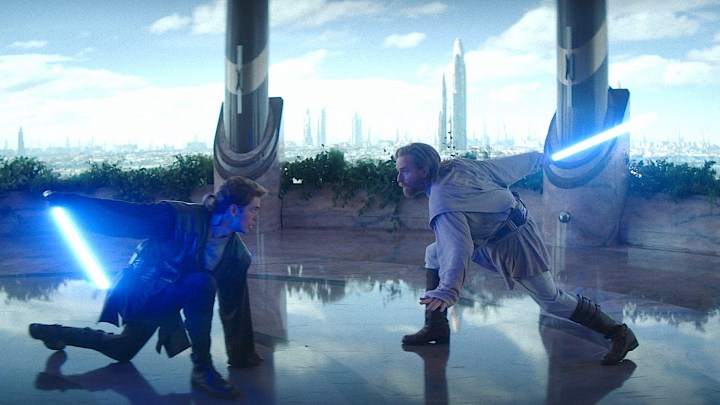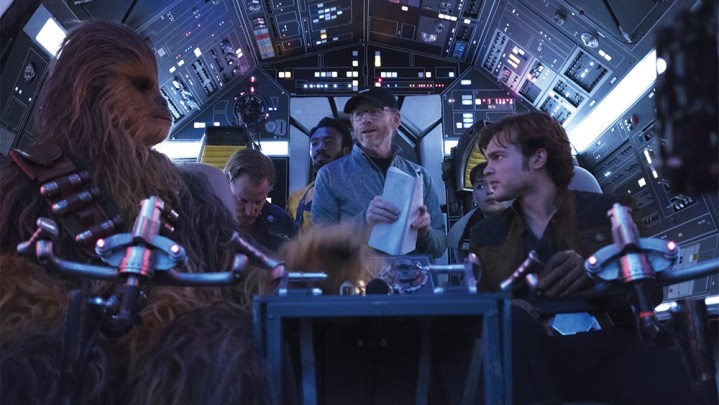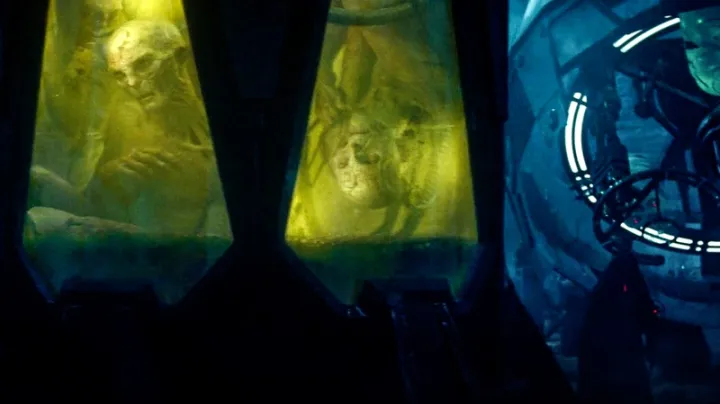There’s no question that the past eigh years of Star Wars have been divisive. No one’s going to debate that. Some fans hate the Sequel Trilogy but love The Mandalorian and Rogue One. Some adore The Last Jedi but hate Rise of Skywalker. And then there are plenty that only like Andor. And then there are people like me, who find plenty to enjoy in all of the above.
There are some decisions, though, that we can all agree didn’t play out how Lucasfilm may have hoped — creatively or financially. These are all things I hope the studio can learn from, to hopefully ensure that we continue to get more expansion of the Star Wars franchise for many years to come. So, let’s count them down from the most harmless to the most egregious.
6. The shoddy production values of Obi-Wan Kenobi

I love this show. I really do. The first and last acts in particular, and how the focus is on Obi-Wan and the building adventure, especially throughout the first few episodes. Unfortunately, I love the show in spite of its sometimes glaring lack of production value. It’s absurd to think that the show that would bring back Ewen McGregor and Hayden Christensen couldn’t garner some more behind-the-scenes support — especially for something that had been in the works for this long. But there’s no question it suffers from some subpar production issues.
There are more than a handful of moments of slapdash CGI, for sure, whether it’s Vader’s ship-tearing scene or a variety of daytime vehicle shots throughout the show. And then there are locations, which can often feel either generic, small, or unintentionally claustrophobic.
But the real culprit behind the look of the show isn’t director Deborah Chow or even a lack of money — it’s the over-reliance on The Volume. The 360-degree virtual soundstage can produce true magic at times, of which season three of The Mandalorian has been an example. But in Obi-Wan Kenobi, too much time on The Volume results in a number of scenes that just feel off. Sometimes it’s awkward blocking, and other times it’s stilted action that lacks urgency and realism. I don’t know about the decision-making behind the overuse of The Volume, but it clearly wasn’t pushed as hard in Andor, which balances location shooting and The Volume with more nuance. Hopefully, that’ll continue to be the case in shows moving forward.
5. The logo moment

Eager to capitalize on the success of The Mandalorian (and to forget about the negative response to The Rise of Skywalker), Lucasfilm came to Star Wars Celebration 2020 with an agenda. An ambitious plan that would show the fans just how serious it was taking the expansion of this franchise. The flash of logos on the screen was the climactic moment, revealing an exciting, Marvel-like slate of upcoming shows and films.
It got me excited, I’ll admit. The idea that we could have this much varied content coming in the future felt like we were in good hands, and that Lucasfilm knew where it wanted to take Star Wars next. Unfortunately, it ended up being a bit overly confident. Of the 11 Star Wars logos that graced the slide, only seven have come to fruition or are currently in active development (not to mention the loss of the Children of Blood and Bone adaptation). Two shows — A Droid Story and Lando — have received zero official updates from Lucasfilm since they were initially announced.
Pattie Jenkins’ Rogue Squadron hurt the most, though. She going to be the first female director of a Star Wars film and there was even a personal video of her climbing into an X-Wing directed by none other than Jenkins herself. Come on!
Ultimately, this massive announcement certainly built excitement for the future of Star Wars but ultimately ended up hurting the studio’s credibility. Since then, Lucasfilm has held its cards much closer to the chest — and that’s been for the better. With three upcoming films and lots of shows on the horizon, Lucasfilm’s more measured approach has begun to build trust again with the wider Star Wars audience, but it’s been an uphill battle.
4. The way The Book of Boba Fett was structured

The Book of Boba Fett came as a complete surprise. Sure, the rumors of a Boba Fett film had long been out there, but the placement of this mini-series within the context of The Mandalorian came out of left field, tacked on as a post-credit scene of season two. Even the sloppy language I just used to describe it demonstrates how confusing its existence was. The result was a complete lack of reference for what to expect out of these seven episodes.
For what it’s worth, I like a lot of what the two halves of The Book of Boba Fett do on their own. I loved how deep the story dove into the Tusken culture in Boba’s past, while also bouncing forward to his expanding command of the cities of Tatooine. There was a compelling vision here, even if it felt like it didn’t get fully fleshed out. I also had plenty of fun with just how grand the show’s climax grew with the reintroduction of so many characters too. And who could have guessed we get this much time with Luke Skywalker in this show?
But the problem is in the way we were presented with the story. It starts off very much feeling like its own show, only to completely be interrupted by episode 5 with The Return of the Mandalorian. When watching it straight through, it really does feel like an intrusion. It’s clear that internally, The Book of Boba Fett was seen as a spin-off of The Mandalorian and functioned as a season 2.5. But for the audience, it ended up being frustrating.
There’s a world in which Jon Favreau and team could have pulled this off. With a few more episodes to build up Boba Fett’s own story and better marketing, The Book of Boba Fett could have been a bigger success. But as is, it’ll likely go down as an experiment gone wrong for many fans.
3. The botched marketing and release of Solo

Solo: A Star Wars Story was the first financial blunder in the era of Disney Star Wars. After three billion-dollar hits in a row, including for the other spin-off, Rogue One, the failure of Solo seemed to take the studio by surprise. Much has been made about the reasoning behind Solo‘s lack of impact, and we’ll likely never be able to narrow it down to a single silver bullet.
But as the first Star Wars film to come just six months after the previous one, especially to follow a divisive film like The Last Jedi, it certainly wasn’t set up for success. There just wasn’t enough time to build a positive message for the film, especially considering this was the first attempt at recasting classic characters. Throw in a turbulent behind-the-scenes story that was increasingly getting out in the public, and you have a recipe for trouble.
As you’ll notice, though, very few of those mistakes or problems have to do with the film itself, which is a shame. Considering the herculean task of rewriting the backstory of one of the most iconic characters in film history, Solo has garnered its own little fan base since its release.
2. Not providing more explanation for the return of Palpatine

I love The Rise of Skywalker. I know, I know — you might not. But despite the fun I have with this final entry, I don’t pretend that the criticism of it isn’t justified, specifically of the hastily-written resurrection of one dark master of the Sith, our beloved Palpatine. Personally, I enjoyed the way the film handles the return, but clearly, it was more of a distraction to the audience than Abrams probably thought it would be. He wanted to dismiss it away to get to the real heart of the film’s story, but in doing so, just left fans hanging. And yes, now’s when you cue your “somehow, Palpatine returned” memes.
I get the desire to make the film not centered on explaining the backstory, though — I really do. But if the film had integrated his return more thoroughly into the plot and characters — it would have more thoroughly accomplished that goal. Similarly, while I didn’t need a lengthy explanation for the origin of Snoke, the way the script so quickly brushes it off only leaves it lingering in your mind throughout the rest of the film given the two movies that came before it. The Mandalorian and other expanded ephemera are filling in that story in a fascinating way, but if Abrams could have found a way to more satisfyingly tie these villains together, a lot of the other problems people have with Rise of Skywalker would have washed away.
After all, there’s nothing wrong inherently with bringing Palpatine back one more time, and I like the way it frames the entirety of the three trilogies. But for a revelation this big, it needed a bit more attention paid to it.
1. Not finding a way to get Luke, Leia, and Han back together

The return of the Big Three was the most thrilling fantasy about the return of Star Wars when it was purchased in 2012. It’s what everyone has wanted for all these years — and finally, they’d all be back on screen together.
But the Sequel Trilogy made a decision early on to not center its story around the Big Three. And for what it’s worth, I think that was the right decision. Establishing new characters was essential for expanding the franchise, especially considering the ages of Mark Hamill, Carrie Fisher, and Harrison Ford. I really do love everything about how these characters were portrayed — the death of Han Solo (and subsequent return in memory in Rise of Skywalker) is tragic, the cliffhanger of Luke Skywalker’s appearance is epic, and Leia shines in The Last Jedi.
But the fact that we never got even just a single scene with all three of them together hurts. Even if it was in a flashback, I just wish we’d gotten something — especially knowing we’ll never get a chance at having them again, at least not without some digital shenanigans. Thank goodness for the short but magical scenes we have between Luke and Leia in The Last Jedi and Rise of Skywalker, which manage to add so much depth to these familiar characters and their connection to each other.


